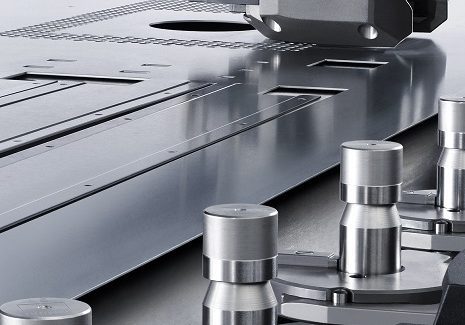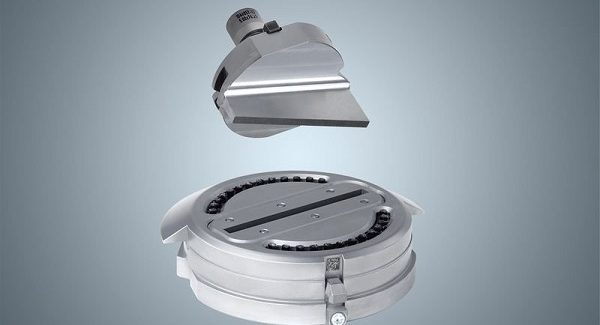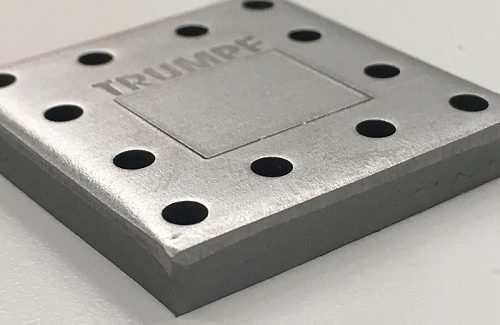Cut-to-Break: Optimizing Punching Operations for a Superior Edge
When it comes to flexible sheet metal fabrication, the punch machine might be a very old dog, but it has shown time and again that it has no problem learning new tricks with modular and interchangeable tooling.
Posted: January 11, 2018
For generations, long before just-in-time became a manufacturing catchphrase, punching technology defined flexible sheet metal fabrication. From early ironworking and template-copy punching machines to modern CNC-controlled punches or punch/laser combination machine tools, this type of equipment has always been well-suited to the needs of small-batch manufacturing – in contrast to the stamping press, the big brother of the punching machine that has dominated the manufacturing of mass-produced sheet metal parts for many decades. The capital costs involved in stamping, along with the expensive tooling required and the time and effort needed to set up jobs, have always limited the profitability of stamping parts in short runs. Enter the punching machine: a “hard tool” machine that is also highly flexible because the tooling is modular and interchangeable.
The modular tooling concept allows punching machines to cut and form various shapes in sheet metal quickly and efficiently. But along with this flexibility comes a new challenge: maintaining a consistent edge quality. Since operators punch out contours in small sections, approximately a couple of inches at a time, longer cuts (called nibble marks) may appear between each hit. This issue can now be overcome because the toolsets are interchangeable and the right tool for each operation can be specified to ensure that the quality of the finished parts remain consistent and nibble marks are avoided.
The conventional wisdom in sheet metal punching is to keep your tools sharp if you want to cut good parts, and this is important advice. The duller the working edges of the tools, the more brute force is required to push them through the workpiece. Sharp punching tools produce a much cleaner cut edge than dull tools, and will also put less wear on the equipment. Punching with dull tools also adds more stress onto the material being processed, which in turn leads to the sheet metal warping or bowing instead of remaining flat and straight. A traditional method for checking tool sharpness is to draw the cutting edge of a punch or die lightly across a fingernail: if the edge cleanly shaves material off your fingernail, it’s still sharp enough to work; if not, it’s time to sharpen the tool.
Selection of the proper tools also have a potential impact on cutting quality. It is always possible to use a range of lower die sizes in combination with one upper tool size. If you are making a round hole in a sheet with a punch that has a half-inch diameter, the opening in the lower die that receives the punch will always be some diameter slightly larger than half an inch. The difference in size between the diameter of the punch and the diameter of the lower die opening is called the die clearance. This clearance must be chosen according to the thickness of the sheet metal to be punched: thicker metal requires a larger clearance so that the punch tools don’t bind with the material. However, the smaller the clearance between the punch and die, the sharper the cutting process will be.
Ultimately, choosing a lower die opening with the smallest feasible clearance will produce a higher quality edge. The type of clearance that’s possible depends on the punch style and the hardness and thickness of the material. This may require some trial and error to find the ideal die clearance for a particular application. A tighter clearance will increase the punching force required, so the tonnage load may need to be considered when choosing the die clearance. Tighter die clearances will also cause the punch to wear faster, requiring more frequent sharpening.
The style of the tool used to punch longer edges will also directly impact edge quality. Most operators will select a rectangular punch for nibbling straight edges because the long dimension of the rectangle translates into faster linear feed rates for cutting and the narrow dimension of the tool results in the kerf width being minimized to reduce tonnage and sheet utilization. In many cases, however, an oblong-shaped punch programmed to overlap slightly between hits can reduce nibble marks compared to a rectangle-shaped punch with sharp edges.
There are also specialized systems available from tool manufacturers that can improve the cut quality of punched products. One example is a shearing toolset, which is designed specifically to eliminate nibble marks on long, straight cuts when used in combination with some programming techniques. These style tools punch without completely separating the slug from the sheet. The material that is being punched out is left slightly attached, then another overlapping hit from the tool cuts a little more of the material, also without separating the slug completely. Repeating these hits several times allows the punch to remove one long slug instead of a bunch of small sections, resulting in long cut edges without nibble marks. These tools create a cut edge comparable to that produced by a straight shear, hence the name.
Another example of a special tool designed to improve finished part quality is a deburring toolset. Rather than being aimed at the cut edge itself, deburring tools are used to eliminate the sharp burrs which are often left behind on the bottom of the part. These tools come in several styles, depending on the type of geometry the user wishes to deburr, such as long straight cuts or inside cutouts. For products such as trays that will be handled, deburring the edges may be a necessity to prevent the products from causing an injury. If this can be done on the punch machine without the need for further finishing, potential savings can be achieved.
Whether your focus is on punching an edge that is aesthetically pleasing to the end user or your part specifications require a high quality cut due to safety or assembly considerations, there are many methods for optimizing results. Talking to your equipment or tooling manufacturer for suggestions is always a good idea because they can help you apply the newest innovations in punching technology. The punch machine for processing sheet metal might be a very old dog, but it has shown time and again that it has no problem learning new tricks.



















